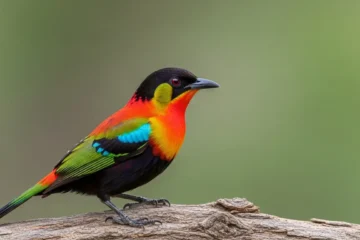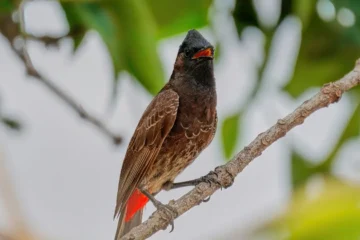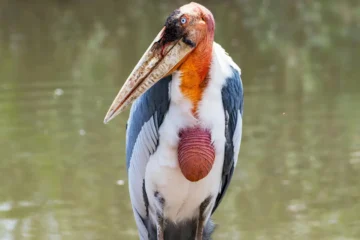The juvenile robin is a young American robin. It is one of the most common backyard birds in the USA. Juveniles have speckled brown breasts and a dull appearance than adults. The adults possess a bright orange chest.
They are often seen hopping on lawns to search for worms and insects. These young robins learn to fly and find food on their own during summer. Watching juvenile robins grow is a familiar and joyful sight for many bird lovers.
Images of Juvenile Robin
Lifespan of Juvenile Robin
A juvenile robin can live about 2 years in the wild, though some reach 5–6 years. They may live up to 14 years in captivity with proper care.
Characteristics of a Juvenile Robin
A juvenile robin has many characteristics that grab attention. Here are some of these key characterisitcs which they possess:
General Characteristic
Feature in Juvenile Robin (USA)
Size
About 6–8 inches long
Feather Color
Brown back with speckled, spotted chest
Beak
Thin, yellowish beak
Eyes
Dark and round
Tail
Medium length, slightly rounded
Habitat
Backyards, parks, and open woodlands
Diet
Mostly insects and small berries
Behavior
Often seen hopping on lawns searching for food
Interesting facts about the Juvenile Robin
Juvenile robins are interesting due to their curious behaviour and lazy habits. Below are some of the interesting facts which appeal to humans:
1. Speckled Chest Pattern
Juvenile robins have a chest covered in light brown speckles. This feature is different form the adult robins with smooth red-orange breasts. These spots help them to camouflage into their surroundings. This mechanism protects them from predators while they are still learning to fly and find food.
The speckled look is temporary and slowly fades as they grow. This natural camouflage is one of the most noticeable differences between young and adult robins. It’s nature’s way of giving them a safer start in life.
2. Shorter Tail Feathers
Juvenile robins often have tails that appear thick compared to adults. This is because their tail feathers are still growing in after leaving the nest. The shorter tails can make their flights look less steady at first. They quickly gain control and learn to take off swiftly.
The tail feathers lengthen as they grow. It helps them balance better during flight. This stage only lasts a few weeks in the summer.
3. Soft and Fluffy Feathers
The feathers of a young robin are softer and fluffier than those of adults. These downy feathers provide warmth but are not as strong for flying long distances.
They give juveniles a puffy appearance when they settle. The fluffiness slowly disappears as they grow. This change shows their readiness for independent life.
4. Curious and Bold Behavior
Juvenile robins are often more curious than adults. They look around the backyards, gardens, and open spaces without much hesitation. They may hop closer to humans while searching for worms or insects.
This boldness comes from inexperience because they have not yet learned to be cautious. It sometimes puts them in risky situations. They develop the alertness typical of adult robins over time.
5. Gentle Chirping Sounds
Juveniles produce softer chirps and squeaky calls instead of the rich songs of adult robins. These sounds are often a way to communicate with their parents when they are hungry.
The calls are vital for survival during the first weeks out of the nest. They start practicing more complex notes as they grow. Some can already sing simple songs by the end of summer.

6. Rely on Parents After Leaving the Nest
Juvenile robins still depend on their parents for food even after they can fly. They follow the adults closely to watch them pull worms and berries from the ground. This post-nesting care can last up to two weeks.
This gives the young birds time to improve their hunting skills. An adult robin can be seen feeding a nearly full-sized juvenile during this stage. It’s an exciting part of their growth cycle in the summer.
7. Playful Pecking Habits
Young robins sometimes peck at leaves, twigs, and even small stones. This behavior is a practice for finding food. They are learning to spot movement in the grass and test different objects with their beaks.
An adult rarely wastes time on inedible things. A juvenile still spends time in figuring it out. This learning is an important step toward independence.
8. Slightly Clumsy Landings
Juvenile robins often land awkwardly because their wings and tail are still developing strength. They can be seen overshooting a branch or losing balance when landing.
These clumsy moments are normal as they practice their coordination. Their flights become smoother and more precise with practice. They can land with the same grace as adults by the end of summer.

9. Gradual Change in Eye Color
A Juvenile robin’s eyes are a lighter shade compared to the deep and dark eyes of adults. The color darkens over the next few months. This slight shift can be noticed by comparing young and adult robins side by side. These small transformations happen during their first year.
10. Short Durations of Flight
Juvenile robins rarely take long flights in their first days out of the nest. They prefer short hops between nearby branches or from the ground to a low area. This allows them to build muscle strength without exhausting themselves.
The flights become long and more confident over time. They can travel just as far as adults by late summer.

11. Different Food Preferences at First
Juvenile Robins tend to rely more on insects in their early weeks rather than a mix of fruits, worms, and insects. The protein helps them grow faster. Parents usually bring insects that are easier to swallow.
They gradually introduce their young to berries and other plant foods. This slow dietary shift prepares them for the mixed food of an adult robin.
12. Strong Sibling Bonds
Sometimes Juvenile robins stay together in small groups when they are from the same nest. They may rest or hunt near each other for comfort and safety.
This sibling connection is strongest in the first few weeks after leaving the nest. They go their separate ways as the breeding season ends. It’s common to see them roaming together until then.

13. Seasonal Disappearance from Yards
Many juvenile robins disappear from backyards by early fall. This is because they join mixed flocks or move toward areas with more food. Some travel short distances and others migrate farther south.
Their absence is temporary, and many return as fully grown adults by the next spring. It is a breathtaking experience for bird lovers to spot a young robin one year and see it again as an adult.
Sightseeing of a Juvenile robin
Juvenile robins are very joyful to watch as they grow. Here are some famous places in the USA where they can be seen:
| Exact Location | State in Which it is Located |
| Central Park | New York |
| Golden Gate Park | California |
| Lincoln Park | Chicago, Illinois |
| Rock Creek Park | Washington, D.C. |
| Griffith Park | California |
| Forest Park | Missouri |
| Prospect Park | New York |
| Fairmount Park | Pennsylvania |
| Piedmont Park | Georgia |
| Balboa Park | California |
| Great Smoky Mountains National Park | North Carolina |
| Mount Vernon Trail | Virginia |
| Audubon Park | Louisiana |
| Highbanks Metro Park | Ohio |
Photography tips for a Juvenile robin
These juvenile robins are adorable to watch as they play around. It is memorable to take a nice photo when there is an opportunity.
- Take photos early in the morning when the light is soft and the bird is more active.
- Keep a safe distance and use a zoom lens to avoid scaring the robin away.
- Focus on the bird’s eye to make the picture look sharp and full of life.
- Capture them near bushes or low branches where they often perch.
- Be patient and still, letting the bird come into the frame naturally.
Final Conclusion on Juvenile Robins
Juvenile robins are duller in color and very lazy compared to the adults. They are very interesting to watch as they learn to survive. They stay close to their parents and siblings till the end of summer. People love to watch them as they turn into adults.
FAQs
Q1: How can you tell a juvenile robin from an adult?
A juvenile robin has a speckled chest and a duller color compared to the bright red chest of an adult.
Q2: What do juvenile robins eat?
They eat soft insects, worms, and berries. They are often fed by their parents until they can hunt on their own.
Q3: How long do juvenile robins stay with their parents?
They usually stay with their parents for about 2 to 3 weeks after leaving the nest.
Q4: Can you feed a juvenile robin if you find one?
It’s best to leave it in the care of its parents unless it’s injured. In which case, a licensed wildlife rehabilitator should be contacted.











